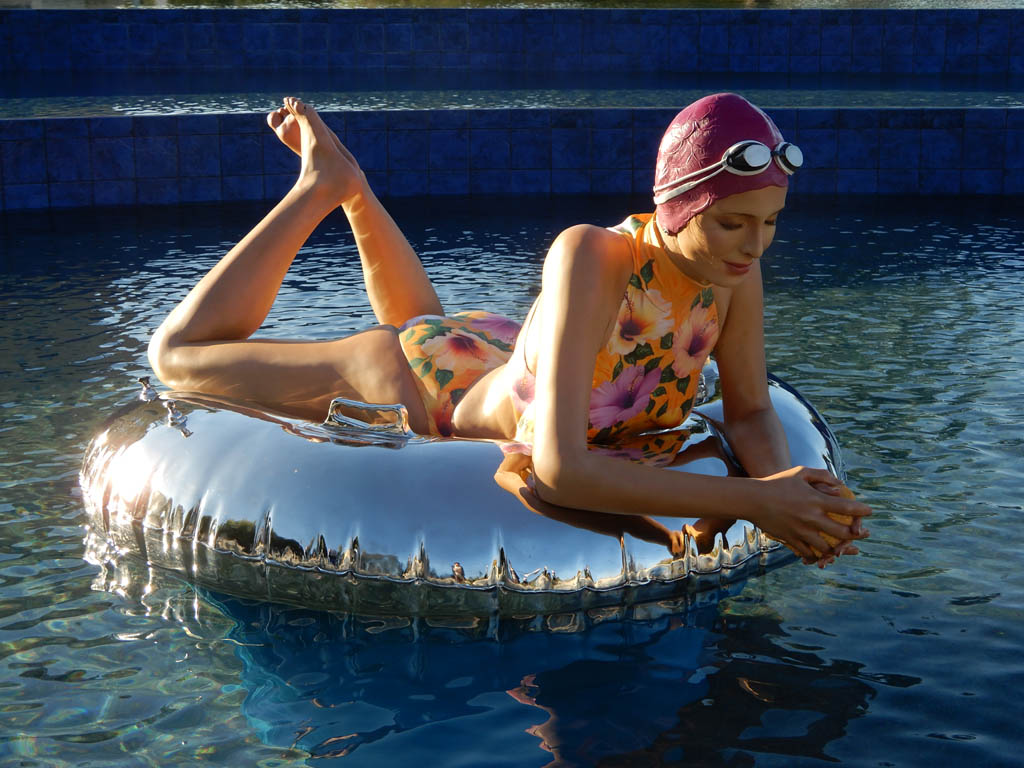
It’s not just her sculpted swimmers that are larger than life. It’s also her fearless determination to champion real-life expressions through her work that has made her such a large presence on the world stage.
Meet petite Carole A. Feuerman, a pioneer in hyperrealism sculpture and an artiste extraordinaire, whose recent outdoor exhibition of bathing beauties, presented by Galeries Bartoux, Patrons Of Park Avenue (Popa), Murray Hill and the City of New York splashed into New York City with show-stopping acclaim this spring in a show entitled Sea Idylls. Posing up and down posh Park Avenue, each of the nine Swimmers is a monumental study of emotions thoughtfully played out in wet faces and postures that speak volumes about feminine strength, resilience and serenity, character traits lifted from her own personal life experiences.
“The symbolism of water is profoundly deep,” she explained, finding its presence to be an enduring symbol for life, and one that she clearly identifies with. Always fascinated by the mechanics and patterns of water, she found inspiration for her pioneering art at the beach, watching swimmers emerge from the water, hair and skin dripping and glistening in the sun, faces and bodies blissfully revived, eyes closed in deep contemplation.
“I remember one particular day being at the beach with my three small children and seeing this young woman come out of the Long Island Sound in a forward position with a look of serenity on her face that captivated me, ultimately taking my art – and life – in a new direction.”
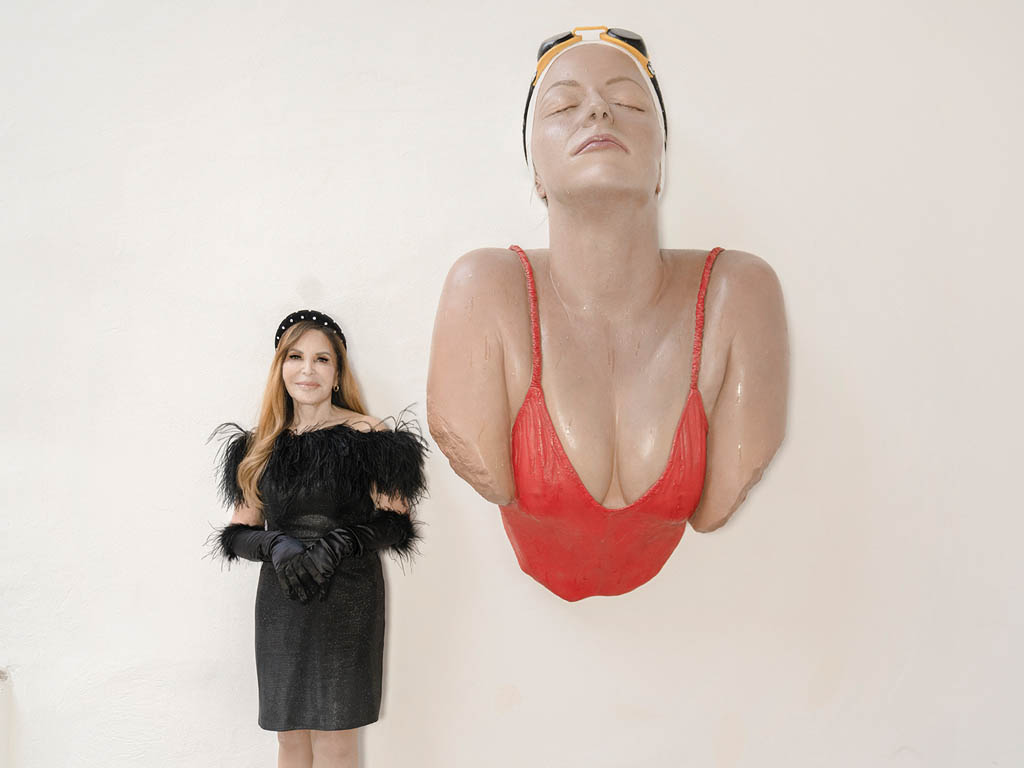
Catalina
The woman became the reimagined model for the first of her swimmers, Catalina, a sculpture she literally put her heart and soul in. Wearing a red swimsuit, with goggles and a bathing cap covering her hair, Catalina is one of her fragmented pieces, a torso sculpted without full limbs to allow the viewer to complete the story.
Carole didn’t do full body figures back in the 1970s, starting with art on the wall, before, as she tells it, coming off the wall to stand on its own. Curiously, her art has kept pace with the events of her own life, first as the married mother of three, anchored to her split role as full-time caretaker and part-time artist, then as a single mom determined to become her own person, and on her journey to become one of the world’s most prominent hyperrealist sculptors and the only woman to do so.
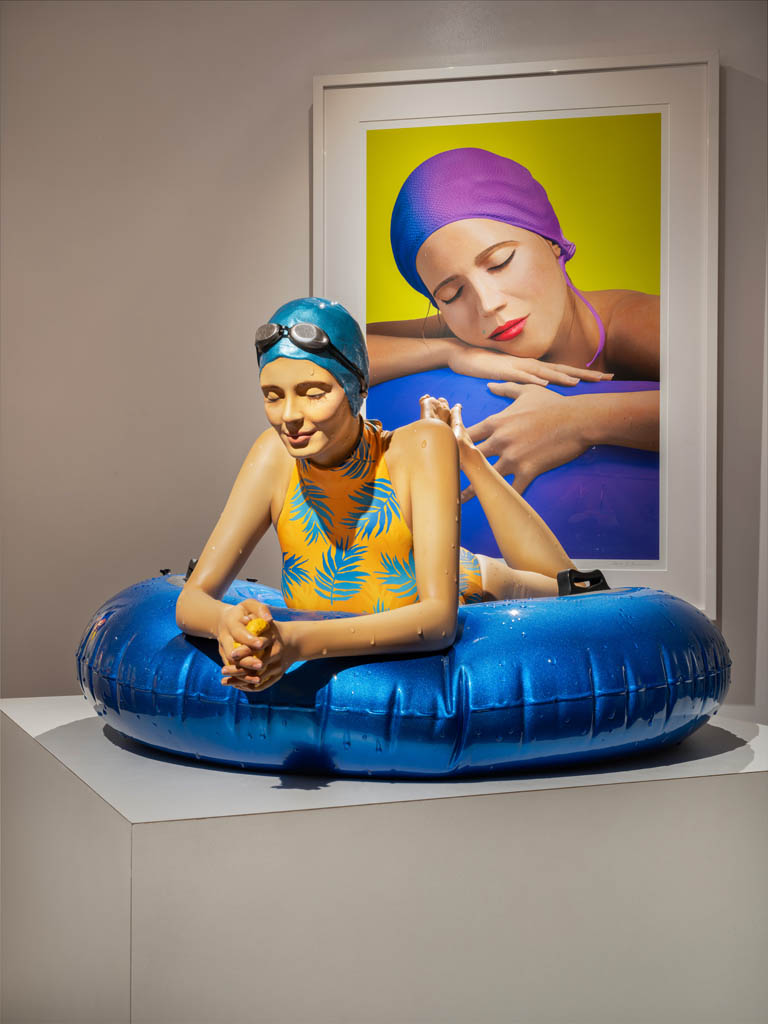
NEXT SUMMER, Epoxy and Lacquer, 14 x 21 x 25 in. 2023
A deep dive into hyperrealist sculpture
“That moment on the beach, when I decided to do swimmers, was life-changing for me. That was one of the first times that I decided to put my own feelings into my work, rather than illustrating someone else’s ideas,” she admitted with the honesty and candor she – and her swimmers – are known for.
She studied art in high school and college, earning her college tuition at the School for Visual Arts as an illustrator of record albums for high-profile musicians that included the Rolling Stones and Alice Cooper who used her paintings as posters for their world tours. Self-taught, she began to sculpt figures after being given an assignment by her art teacher to create something erotic.
“I never really thought about what erotic actually is and, after questioning its meaning, I decided that erotic was not sexual, it was intellectual. I made a series of humorous erotic sculptures back in the late ‘70s after graduating from college, but unfortunately, no gallery would show them. It was very discouraging because it was my first major failure in my art career.”
She did have one opportunity to exhibit her erotic art in a new gallery in Fort Worth, Texas, but after no one showed up at her opening, other than her parents and her children who accompanied her on the trip, the owner pulled the exhibit and sent her packing back to New York.
“I was devastated and decided never again to do erotic art,” she said, recognizing at the time that maybe the work she deemed intellectual, rather than erotic, was not wholesome and that’s why galleries wouldn’t show it. That’s when she took her children to the beach and had her career-making epiphany about swimmers.
Sink or Swim
“I sat on the beach thinking about what to do with my life. I wasn’t going to give up. I was going to do swimmers. They’re wholesome I thought to myself. Little did I realize that this swimmer that so captivated me was also very sensual.”
A trip to the Florida Keys in the early ‘80s inspired her next swimmer, one that depicted the plight of immigrants she saw floating in tubes coming from Cuba. Serena, her iconic sculpture of a girl resting her arms on a life-saving tube, embodies the quest for survival, that women, including Carole herself, have embarked on during life’s many challenges.
“These sculptures tell my story and they all come from my life. But they are also universal in their ability to engage people who see them. Catalina was me seeking rebirth and renewal in the water. Serena represents the immigrants, but she was also me surviving against the odds. Her sculpture Perseverance tells you to never give up, to go after your dreams, and Justice, now a reflective centerpiece of her Park Avenue installation, embodies inner balance and invites viewers to take time out for their friends and family and not just work all the time. The beach ball sculptures represent my children, all children, playfully blissfully on the beach, cares cast away.”
JUSTICE, Bronze, and Lacquer, 112 x 86 x 86 in. 2023
Without exception, every one of her sculptures, each two plus years in the making, tells a story of humanity, while chronicling the artist’s own personal experiences. Vividly realistic down to the exquisite details of individual eye lashes, strands of hair, swimwear and the subtleties of various facial expressions, her work is uniquely her own.
At the time she was first trying to exhibit her life-like swimmers, another artist, Duane Hanson, was making his mark as a hyperrealist sculptor. He was best known for sculpting everyday working-class people and dressing them in real clothes, instead of crafting them out of bronze or resin as Carole does. He happened to have a show at the Whitney Museum when Carole approached Ivan Karp, who ran the prestigious OK Harris Gallery in New York City’s Soho neighborhood, with her Innertube sculpture, now known as Serena, in hand, and asked if he would exhibit her work. “I didn’t give him the opportunity to ignore me, putting my art front and center as I walked into his gallery,” she recalled. Beyond impressed with her work and tenacity, he agreed to show her pieces – and they were a big hit right out of the gate.
“Apparently Duane Hanson was not happy with the competition. As a result, Ivan told me that he couldn’t continue to show me, but that he could introduce me to the gallery across the street. I exhibited successfully at that gallery for the next 17 years, but sadly, did not receive the credit, recognition or money that Duane did as a fellow pioneer of the hyperrealism movement. His pieces were selling for five times what mine were because of his reputation and curators believed that he would enhance their shows if they exhibited his work. Women hadn’t broken the glass ceiling back then. I really wasn’t credited for my role in launching hyperrealist sculpture until 10 years ago, even though I have shown my work all over the world, in 18 different regimes and at leading international art shows.”
I mentioned Seward Johnson to her, an artist whose distinctive bronze sculptures are found in cities and towns throughout the United States, most notably in Princeton, New Jersey, asking her about his fame as a realist sculptor and her interactions with him. She surprised me with her answer.
“I remember one particular day being at the beach with my three small children and seeing this young woman come out of the Long Island Sound in a forward position with a look of serenity on her face that captivated me, ultimately taking my art – and life – in a new direction.”
“We were close friends and he respected my work. He commissioned me for a piece for his Grounds for Sculpture park in Hamilton, New Jersey, which he founded with the Atlantic Foundation. He asked me to do Employee Shower. It’s a nude girl in the shower. The story behind it was that she was a waitress who had a date after work. She goes to take a shower and you can glimpse her in the shower as you walk past. I made the clothes that hang on the hooks too, a jean jacket and a bra among them, all made out of bronze. In summer and winter, water goes from the shower onto the grass. I asked Seward why he commissioned me to make this sculpture. After all, he was a realist artist too. He replied, ‘If I could do it like that, I would have.’”
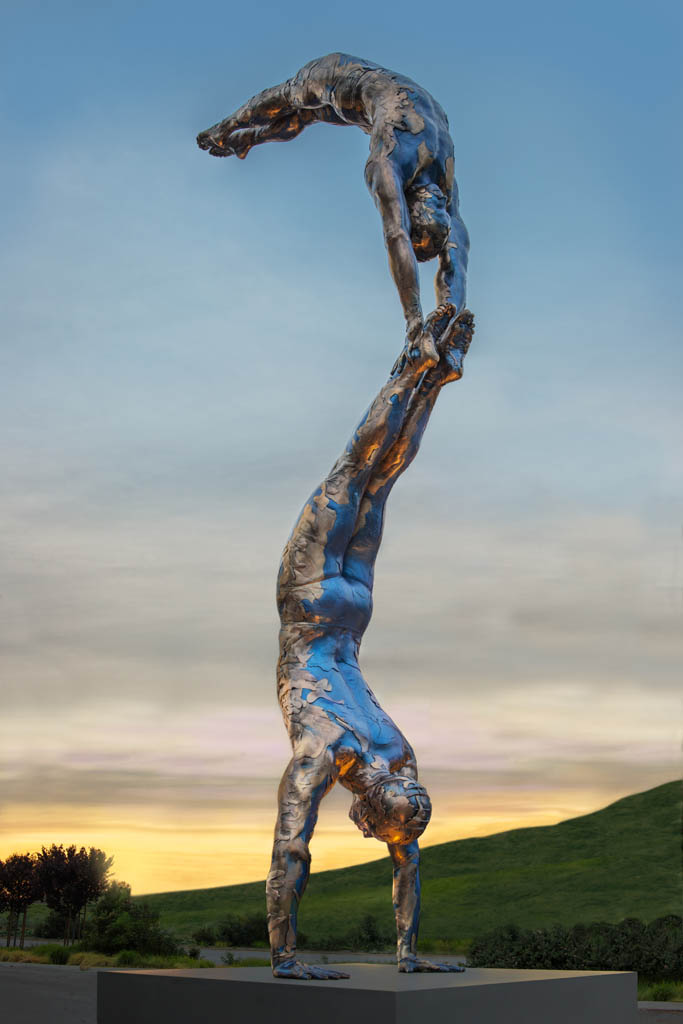
DOUBLE DIVER, Bronze, 432 x 44 x 42 in. 2014
Carole has two pieces in that famous sculpture park, along with many others standing tall in unexpected places all across the globe. Domestically, you’ll see them in cities like Peekskill and Beacon, New York, Miami, Florida, and in Sunnyvale, California, where one of the pieces she’s most proud of, her 36 foot tall sculpture called Double Diver spiraling in the air atop six -inch wrists, make a hugely impressive splash, both for its visual impact and its engineering innovation.
In addition to her current Park Avenue exhibition, on display in Manhattan now through December 10, she will soon be bringing her goddesses to Athens and Mykonos, Greece, where they will be right at home, and has been tapped by a panel of world-renowned scholars to sculpt a masterpiece depicting ancient Egypt for installation in that historic country, which is scheduled to open in mid-October. As we spoke, she was making plans to fly to Italy, where her work will grace the Cloister of Santa Chiara, tucked away behind a 14th-century convent church in the historic heart of Naples, and a magnet for visitors.

CROSSING THE SEA
Solo exhibition curated by Demetrio Paparoni and promoted by the Made in Cloister Foundation and Bel-Air Fine Art.
Piazza Enrico de Nicola, 48, 80139 Napoli NA, Italy
Which brings me to another observation about this multi-talented artist. To accomplish what she does with apparent seamless ease, how does she describe herself in terms of her art? Is she an architect, an engineer, a painter, a sculptor or all of them together, powerfully packed into one pint-sized package? She replied that she was a mother first, that she had a creative agency, was a professional astrologer, was in real estate and admittedly was a lot of things. But as an artist, she considered herself to be a sculptor.
She laughed as she told me that her journey as a sculptor wasn’t totally a bed of roses. “I call it jello on wheels, a little bit up, a little bit down. The idea, I always told myself, is to keep going no matter what. I’m good, I love what I’m doing. It only takes one gallery to discover you so don’t stop, dive in, head first.”
In her quest to have her art seen in her home state, she took her Swimmers all over New York and couldn’t find a gallery to exhibit them. “I did get a week-long show in the Fuller building, which at the time was the most important gallery building in New York. I brought in my Swimmers and some sports figures that I did, a hockey player, a baseball player, but nothing was selling. I had only a few days left in the show when the owner asked me to bring in my erotic pieces. I refused, saying I would never show those again, but he insisted and told me he would keep them in the back room where nobody else would see them. I had nothing to lose so I brought them in.”
“You never know who is going to walk in the door to see your art and on the last day of the show, an older man walked in and went directly to the back room. He came out and wanted to talk to me but I was busy talking to someone else. He waited more than 30 minutes to talk to me when he came up to me again and asked to speak with me. ‘Do you know who I am?” he asked. I didn’t, so he introduced himself. ‘I’m Malcolm Forbes.’”
Stunned, Carole apologized and asked him what she could do for him. “He said, ‘well, I love your erotic pieces and I want to buy them all. I am a capitalist and I don’t pay retail. So call me Monday morning at 8 am and give me a special price. I will let you know if I will buy them all or pass.”
He did buy them all, as well as many others over the years. He even wrote her up in a Christmas issue of his wildly popular Forbes Magazine. Her work started selling after that, making its way into the private collections of top art collectors, celebrities and luminaries who appreciated her genius. She had exhibitions in leading galleries and the press loved her.
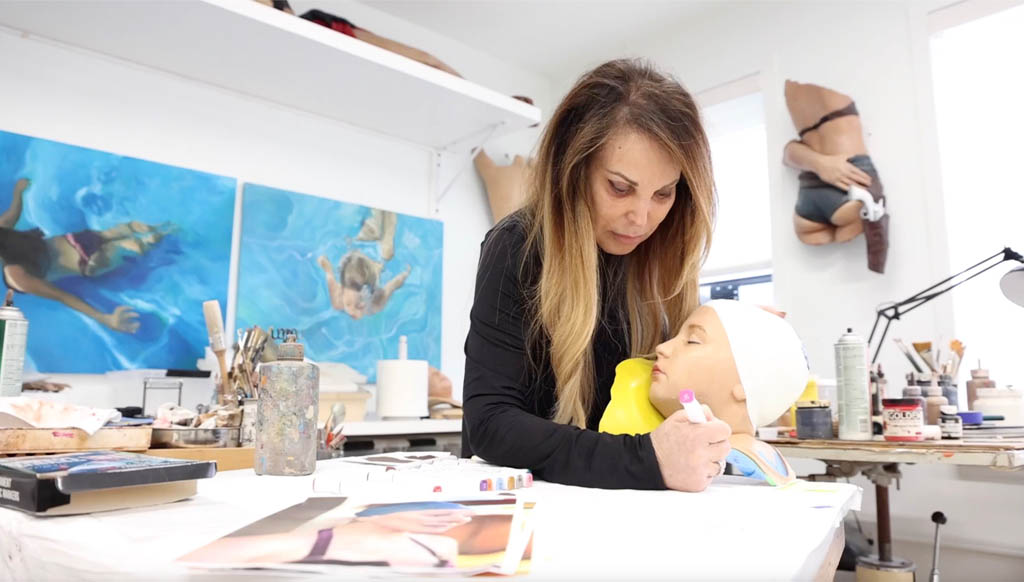
Carole Feuerman in her studio
“But I wasn’t accomplishing all my bucket list things. No New York museum would include me in their shows. The realists they exhibited were all men. I submitted my work to public venues but they didn’t seem to understand it. They were not accustomed to swimmers as art,” she confided.
“One day an art historian named John Spike, who lived in Italy, walked in and invited me to show my work at the Venice Biennale, one of my bucket list aspirations! He explained that it wouldn’t be in the show exactly, but would stand at the front gate where everyone would see it. He didn’t want a small piece either, he wanted something monumental, mentioning that if the pyramids had been small, no one would go to Egypt to see them. He wanted Catalina and Serena, but he wanted them to be super-sized. The caveat: I had to get them there on my own dime.”
She emptied her savings account and took all the money she had to make her pieces larger-than-life and transported them to Venice in time for the opening. They were so well-received that people lined up to see them, even though technically they were not part of the show. A photographer took a picture of a woman kissing her Serena sculpture that wound up on the cover of the Biennale Magazine, a highly coveted honor for an artist. Her sculptures were a huge success and invitations to exhibit her work in Monaco and St. Tropez, France, and other European countries followed in spades after that.
“People all over Europe would ask me for my autograph. Important collectors and galleries opened their doors to me, but back in New York, I still couldn’t get into a top gallery.”
You may be familiar with the saying, “If you can make it in New York, you can make it anywhere.” Now that her Swimmers are causing a sensation along Park Avenue in a long-overdue procession of perfection as well as in a solo restrospective exhibition at the city’s Galeries Bartoux on Central Park South, does Carole feel like she made it?
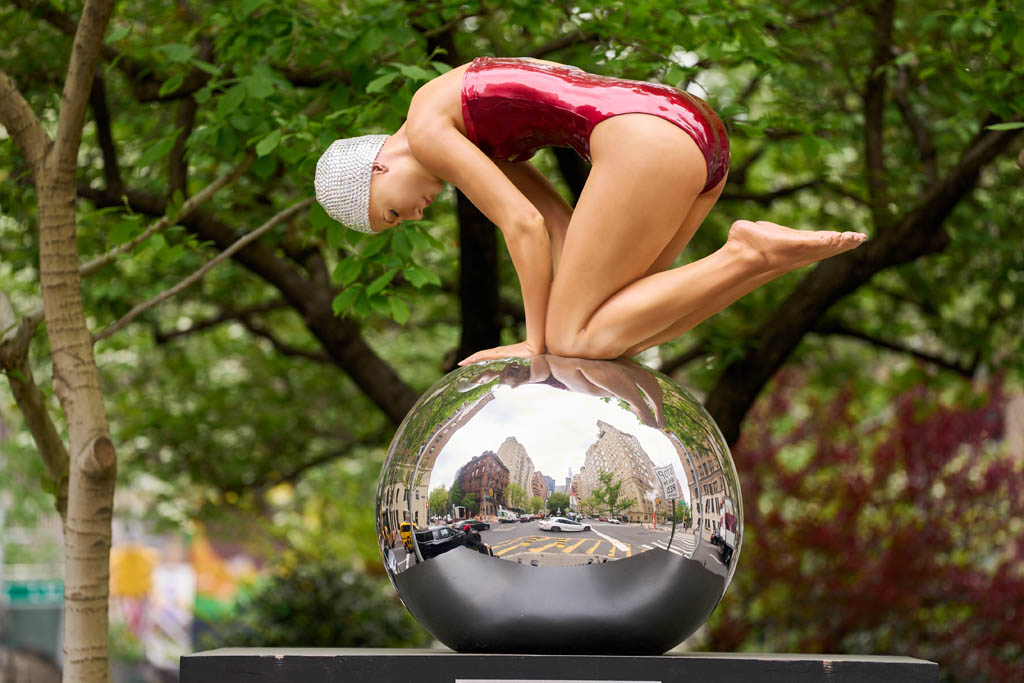
MONUMENTAL QUAN, Bronze, Lacquer, 66.50 x 60 x 43 in, Stainless-Steel Ball
“At the Park Avenue ribbon-cutting ceremony of Sea Idylls, it was the coolest thing. The police had to stop traffic on both sides of the street as hundreds of people came out to see the swimmers. There were huge fans everywhere, students, visitors and people who wanted to sketch my pieces, which is so nice to see,” she answered.
She didn’t boast about being the belle of New York’s most privileged street but I could sense the pride in her voice, the emotions she felt and the experiences she endured to get where she is today. It was gratifying for her to see that she has finally made it everywhere.
Passing the Baton
A true pioneer of the hyperrealist movement in the 1970s, Carole A. Feuerman is one of the most prominent hyperrealist sculptors of our time. She has received multiple awards including the Lifetime Achievement ‘Goddess Artemis” Award from the European American Woman’s Council (EAWC). She has also received the Special Honor Award in Changzhou CHN, Best in Show in Beijing CHN, the Amelia Peabody Award, First Prize at the Olympic Fine Art Exhibition in Beijing, and the Medici Award in Florence ITA. She has taught, lectured, and given workshops at the Guggenheim Museum and the Metropolitan Museum of Art.
She has four full color monographs and two autobiographies in English and Italian. Her works are in the permanent collections of thirty-one museums and owned by the cities of Sunnyvale CA and Peekskill NY, the State Hermitage, El Paso Museum, Steven A. Cohen, Former President Clinton, The Frederick R. Weisman Foundation, the Caldic Collection, Maluma, Dr. Henry Kissinger, and Malcolm Forbes.
As she looks back at the hardships she faced growing up and as a young adult, times that included being disowned and re-owned over and over again by her parents because of her career choice and her divorce, Carole Feuerman believes it was necessary for her to have emotional content for her work. It took real-life experiences to teach her about perseverance, balance and survival and taking care of herself as a strong woman able to stand up and endure the challenges that threatened to block her path. She had many doors closed to her but she didn’t stop moving forward until she found ones that opened. Everything she experienced led her to do the work she does today.
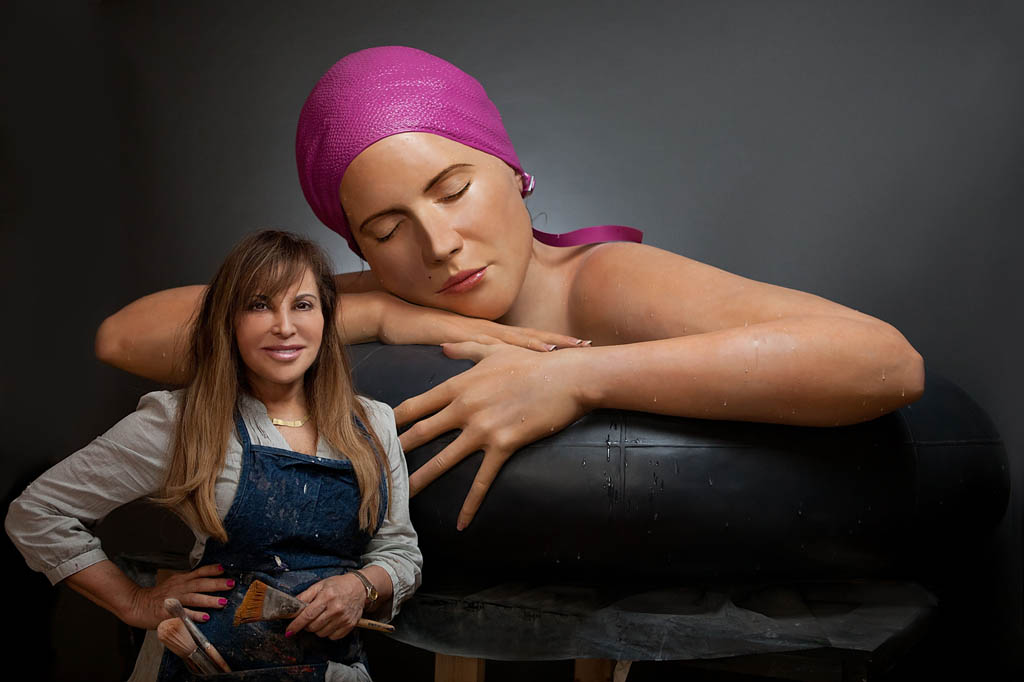
SURVIVAL OF SERENA, Lacquer on Epoxy, 43 x 81 x 36, 2020
It is with those lessons in mind that she became a member of The International Women’s Forum, founded in 1974. Today it is an elite organization comprised of over 7,800 preeminent women leaders in 33 different countries and 73 local forums, who have accomplished something on their own and have given back to others. It is the only organization of this scale that builds significant relationships between C-level women across countries and careers. Carole fits right in with their illustrious members, and has established the Carole A.Feuerman Art Foundation to support struggling artists with grants for their work. To help her fund the foundation, she has created a boutique on her website that sells her designs with all proceeds designated to help artists. Check it out at www.carolefeuermanfoundation.org and help her pass the baton. ☐


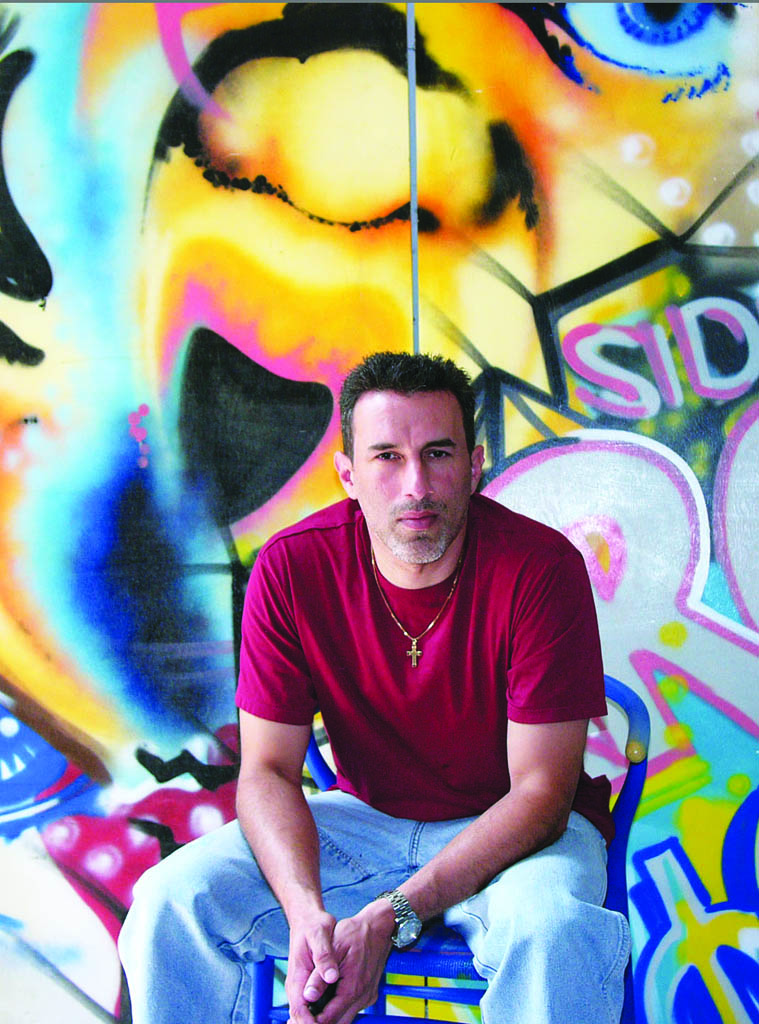
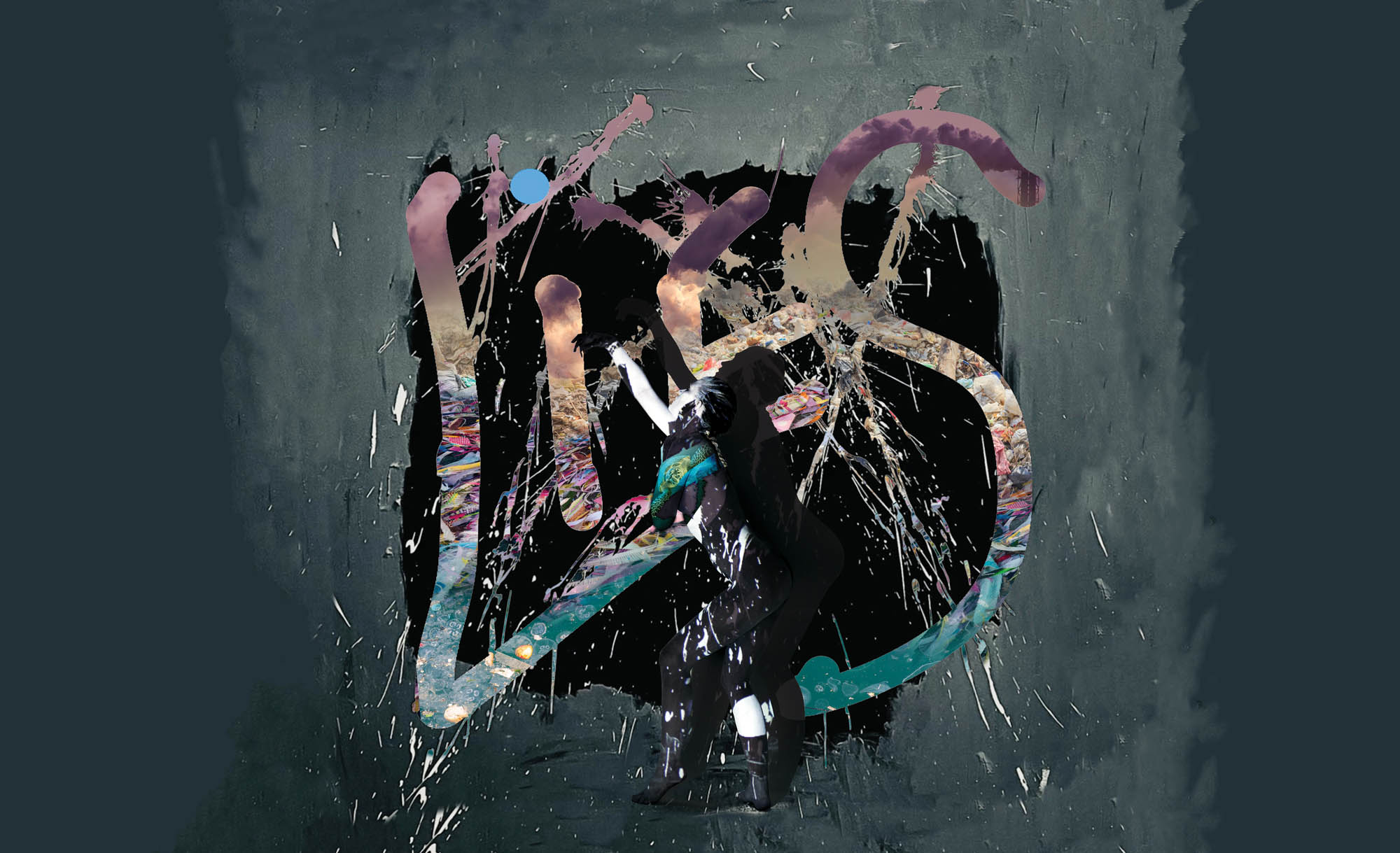

Leave a Reply